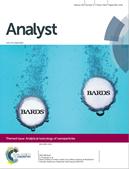
The authors work features on the front cover of Issue 5
This blog has been written by Adam Davis, a Guest Web-Writer for Analyst and Analytical Methods.
Enteric coatings are used to protect acid labile active pharmaceutical ingredients upon entry into the stomach, allowing for controlled and sustained release of active ingredients to the small intestine later. Enteric coated formulations typically consist of a sugar core, a layer of active ingredient followed by the enteric coating. Using current analysis methods determining the thickness of these layers can take up to 24hrs.
In this article, which appears in Issue 5 of Analyst, researchers from University College Cork, Ireland and Kinetox, Netherlands, have demonstrated how Broadband Acoustic Resonance Dissolution Spectroscopy (BARDS) can be used for rapid profiling of enteric coated spheres. The BARDS technique is a novel approach which utilises the acoustic signature of cores spheres and enteric coating as they dissolve, which arise as result of the changes in compressibility of the solvent as a compound dissolves in it. This alters the speed of sound through the solvent, which in turn changes the frequency in solution. The use of BARDS has important implications for manufacturing, quality assurance and stability testing for pharmaceuticals.
Rapid profiling of enteric coated drug delivery spheres via Broadband Acoustic Resonance Dissolution Spectroscopy (BARDS)
D. Fitzpatrick, R. Evans-Hurson, Y. Fu, T. Burke, J. Krüse, B. Vos, S. G. McSweeney, P. Casaubieilh and J. J. Keating
Analyst, 2014, 139, 1000-1006
DOI: 10.1039/C3AN01809A














